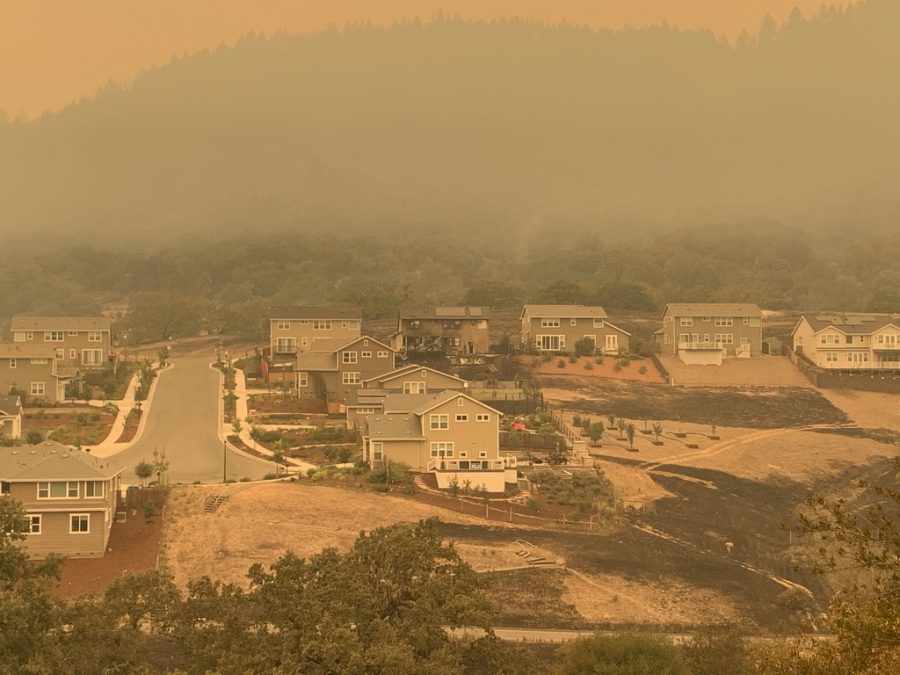The evacuation call came at 7:47 p.m. Sunday evening Sept. 27 for Sophia Ginsberg, 18, an environmental science major at SRJC. The Shady Fire had erupted and was approaching the back of her family’s Santa Rosa property from the west.
“We were alert…and combined with the hot day, we knew we were in danger,” Ginsberg said. Neither of her parents got any sleep Sunday night, and she and her brother only managed to get in two hours.
“By Monday morning it was super, super smoky,” she said. The family finally made the call to evacuate their property at 3 p.m. Monday amid thickening smoke. “We were starting to see smoke plumes creeping up from the back side of the Gates Road area. And it was slow, but it was definitely coming,” Ginsberg said.
The wildfires that continue to ravage Northern California, as they have over the past three years, have left students feeling as though mid-semester evacuations are the new normal. As Nicole Drawsky, 19, said in a post on the SRJC app, “It’s almost a yearly ritual now, so you get used to the fire in some ways. The worst part is always still trying to do school and work and act normal during it.”
For some students, the fire season started as early as Sept. 7 with the outbreak of the Oak Fire in Willits. SRJC student Ingrid Kerr had to evacuate with three pets, explaining, “My husband stayed behind to protect the house from looters since all of Brooktails was evacuated and empty.”
More recently, student lives were upended by the Glass Fire incident, which initially started as three separate Glass, Shady, and Boysen fires. Both Brittany Arias, 26, and Ginsberg expressed the terror they felt seeing the eerie red-orange glow creep slowly towards their homes in the hours before evacuating.
“When I was facing my car, I turned around and saw the hill by Los Alamos Road and there was this orange-red glow behind it, I remember my heart just dropping,” Arias said. In that moment she feared, “Are we going to get out OK, is our house going to be OK?”
Evacuating with animals was a serious concern for students during the Glass Fire. Ginsberg, who lives on her family’s property with their livestock, said she had to leave behind 45 chickens because her family didn’t have a trailer to transport them. However, they managed to evacuate with their two goats, two dogs and seven chicks, adding items like goat food, hay, and oats to their evacuation packing list.
Difficult in particular for Ginsberg was the reality of having to leave her home in uncertain danger. “It was hard because even my dad grew up on that property. Leaving it was really tough,” she explained.
The property, near the Petrified Forest Road intersection on Calistoga Road, typically had a creek running through it every year. “But in the winter of 2019, it didn’t run at all,” Ginsberg said. “So we’ve been having to do a lot of tree work this summer, because we’re drying out up there.”
Ginsberg, who evacuated to Cloverdale, managed a laugh as she recalled the scramble of packing, “Sometimes you grab pretty weird stuff. For example, I packed only clothes for cold weather, so all I have is pants and sweatshirts. I didn’t grab any clothes for hot weather, which I’m regretting, because Cloverdale is in the 90’s today.”
The chaos of evacuating has felt unreal to some, at a time when minds are preoccupied with school deadlines and coronavirus fears. “It’s still crazy to think that when they give out the number of people who have evacuated, me and my family, we’re part of that number. Right now I feel a numbness, it still hasn’t set it yet,” Arias said. Arias, whose family home is on Great Heron Drive in Santa Rosa’s Skyhawk neighborhood, received a push notification to evacuate immediately at 8 p.m. Sunday evening.
“I don’t know if I went into fight or flight mode or autopilot, but I managed to get into my car fine. I sobbed all the way down to the Great Heron intersection with Mountain Hawk to get out, but I was able to drive fine.”
Arias planned to meet her brother at the Krispy Kreme parking lot in Rohnert Park, but after getting stuck in gridlock traffic from Skyhawk to Highway 12, she began to fear that she would have to abandon her car if the situation became dire. Once on Highway 12, the traffic situation didn’t improve. “Occasionally the firetrucks would have to make a U-turn toward Mountain Hawk,” Arias said. “So we had to open the middle lane so they could get through.”
Due to the stress of evacuating, Arias explained that while still important, doing schoolwork has been difficult. “School has been in the back of my head, but given the circumstances, with me, my brother, my parents, and our two cats all in one hotel room, it’s hard to do work, and you’re so mentally exhausted from it.”
For those who may have to evacuate in the coming months, Ginsberg recommends always having a go bag packed with essential items for emergencies.
Students who have lost their homes can apply for the SRJC Student Emergency Grant. The Student Health Services’ page on trauma support and resources can be found here, and students can connect directly with Student Psychological Services or call (707) 527-4445 to set up an appointment.





